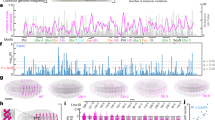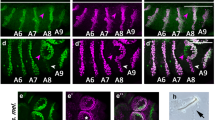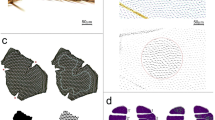Abstract
Morphology evolves often through changes in developmental genes, but the causal mutations, and their effects, remain largely unknown. The evolution of naked cuticle on larvae of Drosophila sechellia resulted from changes in five transcriptional enhancers of shavenbaby (svb), a transcript of the ovo locus that encodes a transcription factor that governs morphogenesis of microtrichiae, hereafter called ‘trichomes’. Here we show that the function of one of these enhancers evolved through multiple single-nucleotide substitutions that altered both the timing and level of svb expression. The consequences of these nucleotide substitutions on larval morphology were quantified with a novel functional assay. We found that each substitution had a relatively small phenotypic effect, and that many nucleotide changes account for this large morphological difference. In addition, we observed that the substitutions had non-additive effects. These data provide unprecedented resolution of the phenotypic effects of substitutions and show how individual nucleotide changes in a transcriptional enhancer have caused morphological evolution.
This is a preview of subscription content, access via your institution
Access options
Subscribe to this journal
Receive 51 print issues and online access
$199.00 per year
only $3.90 per issue
Buy this article
- Purchase on Springer Link
- Instant access to full article PDF
Prices may be subject to local taxes which are calculated during checkout





Similar content being viewed by others
References
Monteiro, A. & Podlaha, O. Wings, horns, and butterfly eyespots: how do complex traits evolve? PLoS Biol. 7, e37 (2009)
Stern, D. L. Evolution, Development, & The Predictable Genome (Roberts & Co., 2010)
Stern, D. L. & Orgogozo, V. The loci of evolution: how predictable is genetic evolution? Evolution 62, 2155–2177 (2008)
Carroll, S. B. Evo-devo and an expanding evolutionary synthesis: a genetic theory of morphological evolution. Cell 134, 25–36 (2008)
Erezyilmaz, D. F., Riddiford, L. M. & Truman, J. W. The pupal specifier broad directs progressive morphogenesis in a direct-developing insect. Proc. Natl Acad. Sci. USA 103, 6925–6930 (2006)
Davidson, E. H. The Regulatory Genome: Gene Regulatory Networks in Development and Evolution (Academic, 2006)
Carroll, S. B., Grenier, J. K. & Weatherbee, S. D. From DNA to Diversity: Molecular Genetics and the Evolution of Animal Design (Blackwell Science, 2001)
Wilkins, A. S. The Evolution of Developmental Pathways (Sinauer Associates, 2002)
Jeong, S. et al. The evolution of gene regulation underlies a morphological difference between two Drosophila sister species. Cell 132, 783–793 (2008)
Rebeiz, M., Pool, J. E., Kassner, V. A., Aquadro, C. F. & Carroll, S. B. Stepwise modification of a modular enhancer underlies adaptation in a Drosophila population. Science 326, 1663–1667 (2009)
Chan, Y. F. et al. Adaptive evolution of pelvic reduction in sticklebacks by recurrent deletion of a Pitx1 enhancer. Science 327, 302–305 (2010)
Nadeau, N. J. & Jiggins, C. D. A golden age for evolutionary genetics? Genomic studies of adaptation in natural populations. Trends Genet. 26, 484–492 (2010)
Phillips, P. C. Epistasis—the essential role of gene interactions in the structure and evolution of genetic systems. Nature Rev. Genet. 9, 855–867 (2008)
Gerke, J., Lorenz, K. & Cohen, B. Genetic interactions between transcription factors cause natural variation in yeast. Science 323, 498–501 (2009)
Weinreich, D. M., Watson, R. A. & Chao, L. Perspective: sign epistasis and genetic constraint on evolutionary trajectories. Evolution 59, 1165–1174 (2005)
Carroll, S. B. Homeotic genes and the evolution of arthropods and chordates. Nature 376, 479–485 (1995)
Akam, M. Hox genes, homeosis and the evolution of segment identity: no need for hopeless monsters. Int. J. Dev. Biol. 42, 445–451 (1998)
Stern, D. L. Perspective: evolutionary developmental biology and the problem of variation. Evolution 54, 1079–1091 (2000)
Wray, G. A. et al. The evolution of transcriptional regulation in eukaryotes. Mol. Biol. Evol. 20, 1377–1419 (2003)
Ludwig, M. Z. et al. Functional evolution of a cis-regulatory module. PLoS Biol. 3, e93 (2005)
Gompel, N., Prud’homme, B., Wittkopp, P. J., Kassner, V. A. & Carroll, S. B. Chance caught on the wing: cis-regulatory evolution and the origin of pigment patterns in Drosophila . Nature 433, 481–487 (2005)
Sucena, E. & Stern, D. L. Divergence of larval morphology between Drosophila sechellia and its sibling species caused by cis-regulatory evolution of ovo/shaven-baby . Proc. Natl Acad. Sci. USA 97, 4530–4534 (2000)
Chanut-Delalande, H., Fernandes, I., Roch, F., Payre, F. & Plaza, S. Shavenbaby couples patterning to epidermal cell shape control. PLoS Biol. 4, e290 (2006)
Payre, F., Vincent, A. & Carreno, S. ovo/svb integrates Wingless and DER pathways to control epidermis differentiation. Nature 400, 271–275 (1999)
McGregor, A. P. et al. Morphological evolution through multiple cis-regulatory mutations at a single gene. Nature 448, 587–590 (2007)
Frankel, N. et al. Phenotypic robustness conferred by apparently redundant transcriptional enhancers. Nature 466, 490–493 (2010)
Kliman, R. M. et al. The population genetics of the origin and divergence of the Drosophila simulans complex species. Genetics 156, 1913–1931 (2000)
Legrand, D. et al. Species-wide genetic variation and demographic history of Drosophila sechellia, a species lacking population structure. Genetics 182, 1197–1206 (2009)
Nielsen, R. Molecular signatures of natural selection. Annu. Rev. Genet. 39, 197–218 (2005)
Tajima, F. Simple methods for testing the molecular evolutionary clock hypothesis. Genetics 135, 599–607 (1993)
Endo, T., Ikeo, K. & Gojobori, T. Large-scale search for genes on which positive selection may operate. Mol. Biol. Evol. 13, 685–690 (1996)
Baines, J. F., Chen, Y., Das, A. & Stephan, W. DNA sequence variation at a duplicated gene: excess of replacement polymorphism and extensive haplotype structure in the Drosophila melanogaster bicoid region. Mol. Biol. Evol. 19, 989–998 (2002)
Andolfatto, P. Adaptive evolution of non-coding DNA in Drosophila . Nature 437, 1149–1152 (2005)
Haygood, R., Babbitt, C. C., Fedrigo, O. & Wray, G. A. Contrasts between adaptive coding and noncoding changes during human evolution. Proc. Natl Acad. Sci. USA 107, 7853–7857 (2010)
Moses, A. M. Statistical tests for natural selection on regulatory regions based on the strength of transcription factor binding sites. BMC Evol. Biol. 9, 286 (2009)
Orr, H. A. Testing natural selection vs. genetic drift in phenotypic evolution using quantitative trait locus data. Genetics 149, 2099–2104 (1998)
Casillas, S., Barbadilla, A. & Bergman, C. M. Purifying selection maintains highly conserved noncoding sequences in Drosophila . Mol. Biol. Evol. 24, 2222–2234 (2007)
Swanson, C. I., Evans, N. C. & Barolo, S. Structural rules and complex regulatory circuitry constrain expression of a Notch- and EGFR-regulated eye enhancer. Dev. Cell 18, 359–370 (2010)
Klingler, M., Soong, J., Butler, B. & Gergen, J. P. Disperse versus compact elements for the regulation of runt stripes in Drosophila . Dev. Biol. 177, 73–84 (1996)
Howard, K. R. & Struhl, G. Decoding positional information: regulation of the pair-rule gene hairy . Development 110, 1223–1231 (1990)
Wittkopp, P. J. Evolution of cis-regulatory sequence and function in Diptera. Heredity 97, 139–147 (2006)
Williams, T. M. et al. The regulation and evolution of a genetic switch controlling sexually dimorphic traits in Drosophila . Cell 134, 610–623 (2008)
Yuh, C.-H., Bolouri, H. & Davidson, E. H. Genomic cis-regulatory logic: experimental and computational analysis of a sea urchin gene. Science 279, 1896–1902 (1998)
Small, S., Blair, A. & Levine, M. Regulation of even-skipped stripe 2 in the Drosophila embryo. EMBO J. 11, 4047–4057 (1992)
Rasband, W. S. ImageJ 〈http://imagej.nih.gov/ij/〉 (United States National Institutes of Health, 1997–2011
Acknowledgements
We thank G. Davis, P. Parikh and P. Valenti for assistance with cloning and the Drosophila Species Stock Center for fly stocks. This work was supported by the Pew Charitable Trusts Latin American Fellows Program in the Biomedical Sciences Fellowship to N.F., a Ruth L. Kirschstein National Research Service Award to D.F.E. (F32 GM 83546-02), Agence Nationale de la Recherche (Blanc 2008, Netoshape) to F.P., and NIH (GM063622-06A1) and NSF (IOS-0640339) grants to D.L.S.
Author information
Authors and Affiliations
Contributions
N.F., D.F.E., A.P.M. and D.L.S. designed the experiments and analysed the data. N.F., D.F.E., A.P.M., S.W. and F.P. performed the experimental work. N.F. and D.L.S. wrote the manuscript. D.F.E., A.P.M. and F.P. commented on the manuscript at all stages.
Corresponding author
Ethics declarations
Competing interests
The authors declare no competing financial interests.
Supplementary information
Supplementary Information
The file contains Supplementary Figures 1-2 with legends, Supplementary Methods and Materials, Supplementary Tables 1-3 and additional references. (PDF 813 kb)
Rights and permissions
About this article
Cite this article
Frankel, N., Erezyilmaz, D., McGregor, A. et al. Morphological evolution caused by many subtle-effect substitutions in regulatory DNA. Nature 474, 598–603 (2011). https://doi.org/10.1038/nature10200
Received:
Accepted:
Published:
Issue Date:
DOI: https://doi.org/10.1038/nature10200
This article is cited by
-
The complex genetic architecture of male mate choice evolution between Drosophila species
Heredity (2020)
-
Motifome comparison between modern human, Neanderthal and Denisovan
BMC Genomics (2018)
-
Shavenbaby and Yorkie mediate Hippo signaling to protect adult stem cells from apoptosis
Nature Communications (2018)
-
Evolution of Shh endoderm enhancers during morphological transition from ventral lungs to dorsal gas bladder
Nature Communications (2017)
-
A de novo silencer causes elimination of MITF-M expression and profound hearing loss in pigs
BMC Biology (2016)
Comments
By submitting a comment you agree to abide by our Terms and Community Guidelines. If you find something abusive or that does not comply with our terms or guidelines please flag it as inappropriate.



